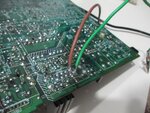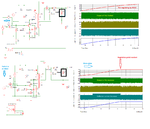E-design
Advanced Member level 5

- Joined
- Jun 1, 2002
- Messages
- 2,014
- Helped
- 507
- Reputation
- 1,016
- Reaction score
- 408
- Trophy points
- 1,363
- Activity points
- 14,193
You may have an open-circuit R609, which will remove the ground reference from pin 2. This resistor senses peak current through the STR and could have gone open due to the fault.
Below is an internal diagram of the STR chip to help understand the working. R609 (R805) can be seen to be in series of the main switching transistor.
When the peak emitter current is too high, the voltage drop over R805 will turn on VT3's base-emitter junction, which will turn on VT2, that will shunt current away from the base of VT1, turning it off.
The opto feedback performs the same function. When the 112/5 V line goes too high, opto turns on, turning on the external PNP (Q801), which also turns on VT2.
Below is an internal diagram of the STR chip to help understand the working. R609 (R805) can be seen to be in series of the main switching transistor.
When the peak emitter current is too high, the voltage drop over R805 will turn on VT3's base-emitter junction, which will turn on VT2, that will shunt current away from the base of VT1, turning it off.
The opto feedback performs the same function. When the 112/5 V line goes too high, opto turns on, turning on the external PNP (Q801), which also turns on VT2.













